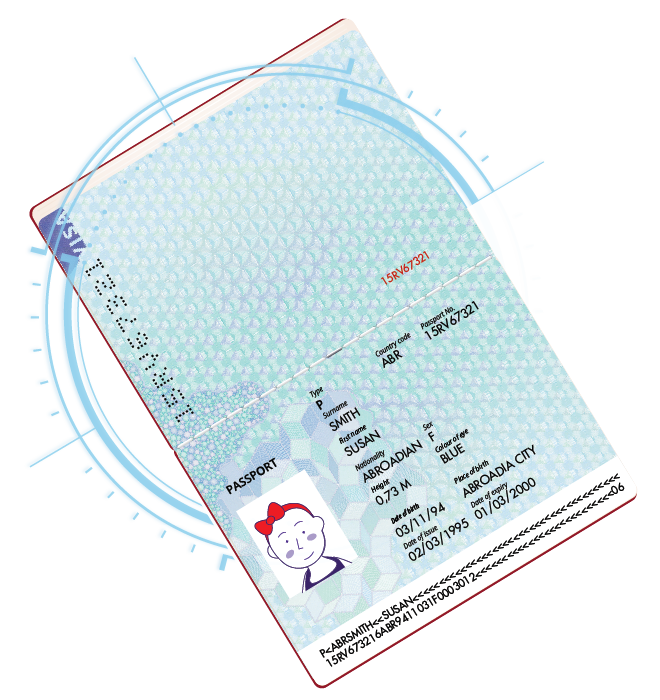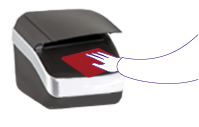A modern passport
for a modern life
Follow Susan's life and discover the evolution of passports throughout the decades

Follow Susan's life and discover the evolution of passports throughout the decades


One billion people* traveled by plane between 1950 and 1990. Global economic growth, the development of tourism and globalization largely contributed to this significant peak in air traffic.
A passport certifies the holder's identity and nationality, and entitles them to cross foreign borders under its protection. In the 1990s air travel was considered a luxury and passports were rare.
Since the 90s we have advanced in leaps and bounds. Today, the passport application process is easy, fast and convenient. And despite the occasional glitch, most administrations have made substantial progress in the last 25 years. In 1994, applying for a passport could take up to two months, from the moment you applied to the delivery of your travel document.
* Source: IATA
In the early 2000s, transport and in particular air transport had set up new security regulations to help counter terrorism.
Tracing passengers and their identity became crucial for all states. In addition, the democratization of low-cost companies entering the market led to a significant rise in the number of travelers. In 2005, the ICAO recommended that all passports should be electronic in order to have an additional layer of security and allow machine readability for more convenience. Today, ePassports have become increasingly popular. 85% of all passports issued are electronic.
Over the 2010s, air travel increased on average by 6% per year*. By 2037, an estimated 8.2 billion travelers** will be visiting the world. Faced with the growing number of passengers, it was necessary for airports to facilitate the passenger flow and organize faster boarding.
Airports also had to manage the risks associated with traveler movements such as identity theft and terrorism. Thanks to the electronic chip in ePassports, travelers could go through eGates securely, smoothly and quickly.
* Source: ICAO
** Source: IATA
Passport fraud implies serious threats for a country and can lead to the development of additional criminal activities. In 2018, INTERPOL estimated that there were approximately 84 million lost and stolen travel documents. Fraudsters are more and more tech-savvy and have access to high-end equipment.
To fight against fraud, governments need to ensure that they are always one step ahead.
In today’s society, consumers are used to instantaneous services tailored to their needs. They do not like to wait and prefer a customized approach. Consequently, when dealing with the new generation of citizens, governments need to adapt and modernize their infrastructure.
Many countries offer a fast track passport service, enabling citizens to receive their passports quickly (for example twelve hours instead of the current five days).
In 2020, the world was impacted by the COVID-19 pandemic that resulted in a significant decrease in international travel. Thankfully, the world is once again open and air traffic is slowly recovering. We are back on track for steady growth in international air travel.
The role of passports has never been so important; not only is it a travel document, but it also represents freedom of movement for citizens.
All passports are different and are ranked depending on the number of countries they provide access to without a visa.
Smartphones have become our everyday digital companion. And many people can’t wait to use the convenience of a smartphone app to travel.
In 2030, Digital Travel Credentials (DTC) have been democratized. This digital identity is stored in the citizen’s smartphone and is derived from their ePassport (linked to biometric data). The physical document is still mandatory, as travelers need to have it with them when crossing borders. This will remain the case until we have transitioned to a full digital travel ecosystem.

The Machine Readable Zone (MRZ) contains personal data (passport number, name, surname and issuance date) which is standardized by the ICAO. This MRZ is checked by controllers using a scanner. Today, this can even be done using smartphones, allowing faster data processing and greater accuracy.
Passports follow strict regulations. The International Civil Aviation Organization (ICAO) is in charge of standardizing the technical features of passports (portrait and personal data of the holder). IDEMIA participates in the ICAO committees and therefore plays a significant role in defining standards.
ISO sets up rules related to the format of passports. As an example, under the ISO/CEI7810 norm, all passports must be 125 mm long and 88 mm wide.

The Machine Readable Zone (MRZ) contains personal data (passport number, name, surname and issuance date) which is standardized by the ICAO. This MRZ is checked by controllers using a scanner. Today, this can even be done using smartphones, allowing faster data processing and greater accuracy.
Passports follow strict regulations. The International Civil Aviation Organization (ICAO) is in charge of standardizing the technical features of passports (portrait and personal data of the holder). IDEMIA participates in the ICAO committees and therefore plays a significant role in defining standards.
ISO sets up rules related to the format of passports. As an example, under the ISO/CEI7810 norm, all passports must be 125 mm long and 88 mm wide.
Enrollment process - capturing Susan’s personal data
Enrollment process - capturing Susan’s personal data
- Biographical data
- Picture
- Fingerprints
- Passport number
The chip-inside symbol was designed at IDEMIA’s Haarlem site.
Citizen data and privacy protection are ensured from the conception to the delivery of the solution.
or eMRTDs follow the specifications as per ICAO document 9303, on deployment of biometric identification and electronic storage of data.
- Biographical data
- Picture
- Fingerprints
- Passport number
The chip-inside symbol was designed at IDEMIA’s Haarlem site.
Citizen data and privacy protection are ensured from the conception to the delivery of the solution.
or eMRTDs follow the specifications as per ICAO document 9303, on deployment of biometric identification and electronic storage of data.


IDEMIA’s TraveLane includes travel document reading and authentication, traveler identity verification, ID fraud detection, passenger eligibility check and Entry/Exit authorization.
More information on TraveLane
IDEMIA’s TraveLane includes travel document reading and authentication, traveler identity verification, ID fraud detection, passenger eligibility check and Entry/Exit authorization.
More information on TraveLane
A complete reproduction of a genuine document (made with false elements or using parts of genuine documents).
Falsification of personal data and/or security features in an ID document.
Ready-to-be personalized documents that have been stolen in order to personalize with false information.
Imposters using genuine documents that do not belong to them (the original photo shows a physical similarity to the imposter).
An authentic document provided by the authorities with false data and/or morphed portrait.
A complete reproduction of a genuine document (made with false elements or using parts of genuine documents).
More information on fighting identity fraud
A complete reproduction of a genuine document (made with false elements or using parts of genuine documents).
Falsification of personal data and/or security features in an ID document.
Ready-to-be personalized documents that have been stolen in order to personalize with false information.
Imposters using genuine documents that do not belong to them (the original photo shows a physical similarity to the imposter).
An authentic document provided by the authorities with false data and/or morphed portrait.
A complete reproduction of a genuine document (made with false elements or using parts of genuine documents).
More information on fighting identity fraud
When citizens apply for a passport, they go to an enrollment center where their biographical and biometric data is captured. They also provide documents such as a birth certificate proving their identity. Applicants usually take delivery of their passport at the same center. Enrollment and delivery centers are located across the country.
The biometric data is compared to the identities stored in the government’s database to ensure that her data has not already been registered. Once verified, approval is sent to the personalization center. The use of biometrics guarantees that her identity is unique.
The data received from the identity system is added to the blank passport. The personalization process consists of two steps:
- Graphical: secure laser engraving of personal data and MRZ
- Electrical: The biographical and biometric data is embedded in the chip and protected by an eMRTD ICAO signature.
The personalization system has flagged Susan’s cousin passport as a priority using fast-track delivery.
At the hospital, the courier verifies the identity of Susan’s cousin before delivering her passport.
IDEMIA provides such solution in Albania.
Click here to discover the story
When citizens apply for a passport, they go to an enrollment center where their biographical and biometric data is captured. They also provide documents such as a birth certificate proving their identity. Applicants usually take delivery of their passport at the same center. Enrollment and delivery centers are located across the country.
The biometric data is compared to the identities stored in the government’s database to ensure that her data has not already been registered. Once verified, approval is sent to the personalization center. The use of biometrics guarantees that her identity is unique.
The data received from the identity system is added to the blank passport. The personalization process consists of two steps:
- Graphical: secure laser engraving of personal data and MRZ
- Electrical: The biographical and biometric data is embedded in the chip and protected by an eMRTD ICAO signature.
The personalization system has flagged Susan’s cousin passport as a priority using fast-track delivery.
At the hospital, the courier verifies the identity of Susan’s cousin before delivering her passport.
IDEMIA provides such solution in Albania.
Click here to discover the story
The power of a passport is determined by the number of countries a citizen can visit without requesting a visa.
Obtaining a visa waiver (a visa-free agreement between two countries for their travellers), is based on multiple criteria, including a solid and secure identity infrastructure. For countries that are willing to maximize their chances to obtain visa waivers, a Public-Private Partnership (PPP) can enable to implement a robust and modern identity infrastructure in a few months.
The power of a passport is determined by the number of countries a citizen can visit without requesting a visa.
Obtaining a visa waiver (a visa-free agreement between two countries for their travellers), is based on multiple criteria, including a solid and secure identity infrastructure. For countries that are willing to maximize their chances to obtain visa waivers, a Public-Private Partnership (PPP) can enable to implement a robust and modern identity infrastructure in a few months.
Susan downloads the smartphone app issued by the government to create her digital travel identity. This identity derives from her passport and is stored directly in her mobile.
- She books a flight with the airline
- She consents to sharing certain attributes of her digital identity with the air travel ecosystem. This facilitates her entire travel experience.
Names:
SUSAN
Nationality:
ABROADIAN
Date of birth:
11/03/1994
Susan downloads the smartphone app issued by the government to create her digital travel identity. This identity derives from her passport and is stored directly in her mobile.
- She books a flight with the airline
- She consents to sharing certain attributes of her digital identity with the air travel ecosystem. This facilitates her entire travel experience.
Names:
SUSAN
Nationality:
ABROADIAN
Date of birth:
11/03/1994
Design for privacy - Susan’s digital travel identity is based on her biometrics and is stored locally in her smartphone.
- Facial and fingerprint biometrics
- Personal data
- Flight information
- Airline
- Airport
- Departure and arrival countries
against the revelant local and international watchlists to carry out a risk assessment.
Susan is declared a bona fide traveler and is allowed into the country.
As the destination country was expecting the Reyes family, they can either use their ePassports, biometrics or smartphones to breeze through the automated border control checkpoint.
Design for privacy - Susan’s digital travel identity is based on her biometrics and is stored locally in her smartphone.
- Facial and fingerprint biometrics
- Personal data
- Flight information
- Airline
- Airport
- Departure and arrival countries
against the revelant local and international watchlists to carry out a risk assessment.
Susan is declared a bona fide traveler and is allowed into the country.
As the destination country was expecting the Reyes family, they can either use their ePassports, biometrics or smartphones to breeze through the automated border control checkpoint.